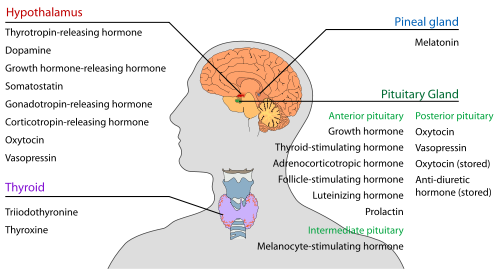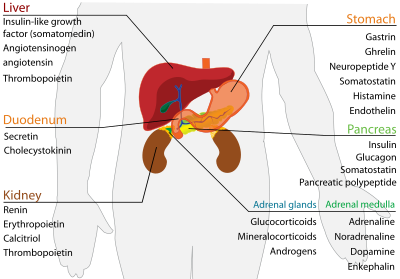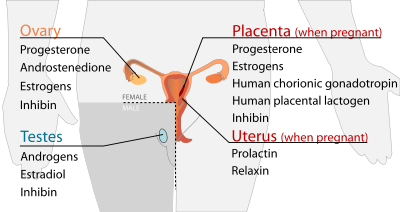
In physiology, the endocrine system is a system of glands, each of which secretes a type of hormone into the bloodstream to regulate the body. It derives from the Greekένδο) meaning inside, within, and crinis (Greek κρινής) for secrete. The endocrine system is an information signal system like the nervous system.
Hormones are substances (chemical mediators) released from endocrine
tissue into the bloodstream that attach to target tissue and allow
communication among cells. Hormones regulate many functions of an
organism, including mood, growth and development, tissue function, and metabolism. The field of study that deals with disorders of endocrine glands is endocrinology, a branch of internal medicine. words endo (Greek
The endocrine system is made up of a series of glands that produce chemicals called hormones. A number of glands that signal each other in sequence is usually referred to as an axis, for example, the hypothalamic-pituitary-adrenal axis. Typical endocrine glands are the pituitary, thyroid, and adrenal
glands. Features of endocrine glands are, in general, their ductless
nature, their vascularity, and usually the presence of intracellular
vacuoles or granules storing their hormones. In contrast, exocrine glands, such as salivary glands, sweat glands, and glands within the gastrointestinal tract, tend to be much less vascular and have ducts or a hollow lumen.
In addition to the specialised endocrine organs mentioned above,
many other organs that are part of other body systems, such as the kidney, liver, heart and gonads, have secondary endocrine functions. For example the kidney secretes endocrine hormones such as erythropoietin and renin.
Endocrine organs and secreted hormones
[edit] Central nervous system

Endocrine glands in the human head and neck and their hormones
Hypothalamus
| Secreted hormone |
Abbreviation |
Produced by |
Effect |
Thyrotropin-releasing hormone
(Prolactin-releasing hormone) |
TRH, TRF, or PRH |
Parvocellular neurosecretory neurons |
Stimulate thyroid-stimulating hormone (TSH)anterior pituitary
Stimulate prolactinanterior pituitary released from (primarily) release from |
Dopamine
(Prolactin-inhibiting hormone) |
DA or PIH |
Dopamine neurons of the arcuate nucleus |
Inhibit prolactinanterior pituitary released from |
| Growth hormone-releasing hormone |
GHRH |
NeuroendocrineArcuate nucleus neurons of the |
Stimulate Growth hormone (GH)anterior pituitary release from |
Somatostatin
(growth hormone-inhibiting hormone) |
SS, GHIH, or SRIF |
NeuroendocrinePeriventricular nucleus cells of the |
Inhibit Growth hormone (GH)anterior pituitary
Inhibit thyroid-stimulating hormone (TSH)anterior pituitary release from release from |
| Gonadotropin-releasing hormone |
GnRH or LHRH |
NeuroendocrinePreoptic area cells of the |
Stimulate follicle-stimulating hormone (FSH)anterior pituitary
Stimulate luteinizing hormone (LH) release from anterior pituitary release from |
| Corticotropin-releasing hormone |
CRH or CRF |
Parvocellular neurosecretory neurons or the Paraventricular Nucleus |
Stimulate adrenocorticotropic hormone (ACTH)anterior pituitary release from |
| Oxytocin |
OT or OXT |
Magnocellular neurosecretory neurons of the Supraoptic Nucleus and Paraventricular Nucleus |
Uterine contraction
Lactation (letdown reflex)
|
Vasopressin
(antidiuretic hormone) |
ADH or AVP or VP |
Parvocellular neurosecretory neurons, Magnocellular neurosecretory neurons of the Paraventricular Nucleus and Supraoptic Nucleus |
Increases water permeability in the distal convoluted tubule and collecting duct of nephrons, thus promoting water reabsorption and increasing blood volume |
Pineal body (epiphysis)
| Secreted hormone |
From cells |
Effect |
| MelatoninDimethyltryptamine |
Pinealocytes |
Antioxidant
Monitors the circadian rhythmdrowsinesscore body temperature including inducement of and lowering of the |
Pituitary Gland (hypophysis)
Anterior pituitary lobe (adenohypophysis)
| Secreted hormone |
Abbreviation |
From cells |
Effect |
Growth hormone
(somatotropin) |
GH |
Somatotrophs |
Stimulates growth and cell
Stimulates Insulin-like growth factor 1liver reproduction release from |
Thyroid-stimulating hormone
(thyrotropin) |
TSH |
Thyrotrophs |
Stimulates thyroxine (T4) and triiodothyroninethyroid gland
Stimulates iodine absorption by thyroid gland (T3) synthesis and release from |
Adrenocorticotropic hormone
(corticotropin) |
ACTH |
Corticotrophs |
Stimulates corticosteroidglucocorticoidmineralcorticoid) and androgenadrenocortical cells ( and synthesis and release from |
| Beta-endorphin |
- |
Corticotrophs |
Inhibits perception of pain |
| Follicle-stimulating hormone |
FSH |
Gonadotrophs |
In females: Stimulates maturation of ovarian folliclesovary
In males: Stimulates maturation of seminiferous tubules
In males: Stimulates spermatogenesis
In males: Stimulates production of androgen-binding proteinSertoli cellstestes in from of the |
| Luteinizing hormone |
LH |
Gonadotrophs |
In females: Stimulates ovulation
In females: Stimulates formation of corpus luteum
In males: Stimulates testosteroneLeydig cells (interstitial cells) synthesis from |
| Prolactin. |
PRL |
Lactotrophs |
Stimulates milk synthesis and release from mammary glands
Mediates sexual gratification |
Posterior pituitary lobe (neurohypophysis)
| Secreted hormone |
Abbreviation |
From cells |
Effect |
| Oxytocin |
|
Magnocellular neurosecretory cells |
Uterine contraction
Lactation (letdown reflex)
|
Vasopressin
(antidiuretic hormone) |
ADH or AVP |
Parvocellular neurosecretory neurons |
Increases water permeability in the distal convoluted tubule and collecting duct of nephrons, thus promoting water reabsorption and increasing blood volume |
Oxytocin and anti-diuretic hormone are not secreted in the posterior lobe, merely stored.
[edit] Intermediate pituitary lobe (pars intermedia)
| Secreted hormone |
Abbreviation |
From cells |
Effect |
| Melanocyte-stimulating hormone |
MSH |
Melanotropes |
Stimulates melaninmelanocytes synthesis and release from skin/hair |
Thyroid
| Secreted hormone |
Abbreviation |
From cells |
Effect |
| Triiodothyronine |
T3 |
Thyroid epithelial cell |
(More potent form of thyroid hormone)
Stimulates body oxygen and energy consumption, thereby increasing the basal metabolic rate
Stimulates RNA polymerase I and II, thereby promoting protein synthesis |
Thyroxine
(tetraiodothyronine) |
T4 |
Thyroid epithelial cells |
(Less active form of thyroid hormone)
(Acts as a prohormone to triiodothyronine)
Stimulates body oxygen and energy consumption, thereby increasing the basal metabolic rate
Stimulates RNA polymerase I and II, thereby promoting protein synthesis |
| Calcitonin |
|
Parafollicular cells |
Stimulates osteoblasts and thus bone construction
Inhibits Ca2+2+ release from bone, thereby reducing blood Ca |
Alimentary system
Stomach
| Secreted hormone |
Abbreviation |
From cells |
Effect |
| Gastrin (Primarily) |
|
G cells |
Secretion of gastric acid by parietal cells |
| Ghrelin |
|
P/D1 cells |
Stimulate appetite,
secretion of growth hormone from anterior pituitary gland
|
| Neuropeptide Y |
NPY |
|
increased food intake and decreased physical activity |
| Somatostatin |
|
D cells |
Suppress release of gastrin, cholecystokininsecretin, motilin, vasoactive intestinal peptidegastric inhibitory polypeptideenteroglucagon (CCK), (VIP), (GIP),
Lowers rate of gastric emptying Reduces smooth muscle contractions and blood flow within the intestine.
|
| Histamine |
|
ECL cells |
stimulate gastric acid secretion |
| Endothelin |
|
X cells |
Smooth muscle contraction of stomach |
Duodenum
| Secreted hormone |
From cells |
Effect |
| Secretin |
S cells |
Secretion of bicarbonate from liver, pancreas and duodenal Brunner's glands
Enhances effects of cholecystokinin Stops production of gastric juice
|
| Cholecystokinin |
I cells |
Release of digestive enzymespancreas from
Release of bile from gallbladder hunger suppressant
|
Liver
| Secreted hormone |
Abbreviation |
From cells |
Effect |
| Insulin-like growth factor (or somatomedin) (Primarily) |
IGF |
Hepatocytes |
insulin-like effects
regulate cell growth and development
|
| Angiotensinogenangiotensin and |
|
Hepatocytes |
vasoconstriction
release of aldosterone from adrenal cortexdipsogen.
|
| Thrombopoietin |
|
Hepatocytes |
stimulates megakaryocytesplatelets[3] to produce |
Pancreas
| Secreted hormone |
From cells |
Effect |
| Insulin (Primarily) |
β Islet cells |
Intake of glucose, glycogenesisglycolysis in liver and muscle from blood
and intake of lipids and synthesis of triglycerides in adipocytesanabolic effects Other
|
| Glucagon (Also Primarily) |
α Islet cells |
glycogenolysis and gluconeogenesis in liver
increases blood glucose level
|
| Somatostatin |
δ Islet cells |
Inhibit release of insulin
Inhibit release of glucagon pancreas. Suppress the exocrine secretory action of
|
| Pancreatic polypeptide |
PP cells |
Self regulate the pancreas secretion activities and effect the hepatic glycogen levels. |
Kidney
| Secreted hormone |
From cells |
Effect |
| Renin (Primarily) |
Juxtaglomerular cells |
Activates the renin-angiotensin system by producing angiotensin I of angiotensinogen |
| Erythropoietin (EPO) |
Extraglomerular mesangial cells |
Stimulate erythrocyte production |
| Calcitriol (1,25-dihydroxyvitamin D3) |
|
Active form of vitamin D3
Increase absorption of calcium and phosphate from gastrointestinal tract and kidneys inhibit release of PTH
|
| Thrombopoietin |
|
stimulates megakaryocytesplateletsto produce |
Adrenal glands
Adrenal cortex
| Secreted hormone |
From cells |
Effect |
| Glucocorticoidscortisol) (chiefly |
zona fasciculata and zona reticularis cells |
Stimulates gluconeogenesis
Stimulates fat breakdown
Inhibits protein synthesis
Inhibits glucose uptake in muscle and adipose tissue
Inhibits immunological responses (immunosuppressive)
Inhibits inflammatory responses (anti-inflammatory) in adipose tissue |
| Mineralocorticoidsaldosterone) (chiefly |
Zona glomerulosa cells |
Stimulates active sodiumkidneys
Stimulates passive water reabsorption in kidneys, thus increasing blood volume and blood pressure
Stimulates potassium and H+ secretion into nephron reabsorption in of kidney and subsequent excretion |
| AndrogensDHEAtestosterone) (including and |
Zona fasciculata and Zona reticularis cells |
In males: Relatively small effect compared to androgens from testes
In females: masculinizing effects (i.e. excessive facial hair) |
Adrenal medulla
| Secreted hormone |
From cells |
Effect |
| Adrenaline (epinephrine) (Primarily) |
Chromaffin cells |
Fight-or-flight response:
- Boost the supply of oxygen and glucose to the brain and musclesheart rate and stroke volume, vasodilation, increasing catalysis of glycogen in liver, breakdown of lipids in fat cells) (by increasing
- Dilate the pupils
- Suppress non-emergency bodily processes (e.g., digestion)
- Suppress immune system
|
| Noradrenaline (norepinephrine) |
Chromaffin cells |
Fight-or-flight response:
- Boost the supply of oxygen and glucose to the brain and musclesheart rate and stroke volume, vasoconstriction and increased blood pressure, breakdown of lipids in fat cells) (by increasing
- Increase skeletal muscle readiness.
|
| Dopamine |
Chromaffin cells |
Increase heart rate and blood pressure |
| Enkephalin |
Chromaffin cells |
Regulate pain |
Reproductive
Testes
| Secreted hormone |
From cells |
Effect |
| Androgenstestosterone) (chiefly |
Leydig cells |
Anabolic: growth of muscle mass and strength, increased bone density, growth and strength,
Virilizing: maturation of sex organs, formation of scrotum, deepening of voice, growth of beard and axillary hair.
|
| Estradiol |
Sertoli cells |
Prevent apoptosis of germ cells |
| Inhibin |
Sertoli cells |
Inhibit production of FSH |
Ovarian follicle / Corpus luteum
| Secreted hormone |
From cells |
Effect |
| Progesterone |
Granulosa cells, theca cells |
Support pregnancy[6]:
- Convert endometrium to secretory stage
- Make cervical mucus permeable to sperm.
- Inhibit immunehuman embryo response, e.g., towards the
- Decrease uterine smooth muscle contractility
- Inhibit lactation
- Inhibit onset of labor.
Other:
- Raise epidermal growth factor-1 levels
- Increase core temperature during ovulation
- Reduce spasm and relax smooth muscle (widen bronchi and regulate mucus)
Anti-inflammatory
- Reduce gall-bladderactivity
- Normalize blood clotting and vascular tone, zinccopper levels, celloxygen levels, and use of fat stores for energy and
- Assist in thyroidboneosteoblasts function and growth by
- Increase resilience in bone, teeth, gums, joint, tendon, ligament, and skin
- Promote healing by regulating collagen
- Provide nerve function and healing by regulating myelin
- Prevent endometrial cancer by regulating effects of estrogen
|
| Androstenedione |
Theca cells |
Substrate for estrogen |
| Estrogensestradiol) (mainly |
Granulosa cells |
Structural:
- Promote formation of female secondary sex characteristics
- Accelerate height growth
- Accelerate metabolism (burn fat)
- Reduce muscle mass
- Stimulate endometrial growth
- Increase uterine growth
- Maintain blood vessels and skin
- Reduce bone resorption, increase bone formation
Protein synthesis:
- Increase hepatic production of binding proteins
Coagulation:
- Increase circulating level of factors 2, 7, 9, 10, antithrombin III, plasminogen
- Increase platelet adhesiveness
- Increase HDL, triglyceride, height growth
- Decrease LDL, fat deposition
Fluid balance:
- Regulate salt (sodium) and water retention
- Increase growth hormone
- Increase cortisol, SHBG
Gastrointestinal tract:
- Reduce bowel motility
- Increase cholesterol in bile
Melanin:
- Increase pheomelanin, reduce eumelanin
Cancer:
- Support hormone-sensitive breast cancers (Suppression of production in the body of estrogen is a treatment for these cancers.)
Lung function:
- Promote lung function by supporting alveoli.
|
| Inhibin |
Granulosa cells |
Inhibit production of FSHanterior pituitary from |
Placenta (when pregnant)
| Secreted hormone |
Abbreviation |
From cells |
Effect |
| Progesterone (Primarily) |
|
|
Support pregnancy[6]:
- Inhibit immunefetus. response, towards the
- Decrease uterine smooth muscle[6] contractility
- Inhibit lactation
- Inhibit onset of labor.
- Support fetaladrenal production of mineralo- and glucosteroids.
Other effects on mother similar to ovarian follicle-progesterone
|
| EstrogensEstriol) (Also Primarily) (mainly |
|
|
Effects on mother similar to ovarian follicle estrogen |
| Human chorionic gonadotropin |
HCG |
Syncytiotrophoblast |
promote maintenance of corpus luteumpregnancy during beginning of
Inhibit immunehuman embryo. response, towards the
|
| Human placental lactogen |
HPL |
Syncytiotrophoblast |
increase production of insulin and IGF-1
increase insulin resistance and carbohydrate intolerance
|
| Inhibin |
|
Fetal Trophoblasts |
suppress FSH |
Uterus (when pregnant)
| Secreted hormone |
Abbreviation |
From cells |
Effect |
| Prolactin |
PRL |
Decidual cells |
milk production in mammary glands |
| Relaxin |
|
Decidual cells |
Unclear in humans and animals |
[edit] Calcium regulation
Parathyroid
| Secreted hormone |
Abbreviation |
From cells |
Effect |
| Parathyroid hormone |
PTH |
Parathyroid chief cell |
Calcium:
- Stimulates Ca2+2+ release from bone, thereby increasing blood Ca
- Stimulates osteoclasts, thus breaking down bone
- Stimulates Ca2+kidney reabsorption in
- Stimulates activated vitamin D production in kidney
Phosphate:
- Stimulates PO44. release from bones, thereby increasing blood PO
- Inhibits PO4kidney, so more PO4 = is excreted reabsorption in
- Overall, small net drop in serum PO4.
|
Skin
| Secreted hormone |
From cells |
Effect |
| Calcidiol3) (25-hydroxyvitamin D |
|
Inactive form of vitamin D3 |
Miscellaneous
Heart
| Secreted hormone |
Abbreviation |
From cells |
Effect |
| Atrial-natriuretic peptide |
ANP |
Cardiac myocytes |
Reduce blood pressure by:
reducing systemicvascular resistance, reducing blood water, sodium and fats
|
| Brain natriuretic peptide |
BNP |
Cardiac myocytes |
(To a lesser degree than ANP) reduce blood pressure by:
reducing systemicvascular resistance, reducing blood water, sodium and fats
|
Bone Marrow
| Secreted hormone |
From cells |
Effect |
| Thrombopoietin |
liver and kidney cells |
stimulates megakaryocytes to produce platelets |
Adipose tissue
| Secreted hormone |
From cells |
Effect |
| Leptin (Primarily) |
Adipocytes |
decrease of appetite and increase of metabolism. |
| Estrogens Estrone) (mainly |
Adipocytes |
|
Major endocrine systems
The human endocrine system consists of several systems that operate via feedback loops. Several important feedback systems are mediated via the hypothalamus and pituitary.
- TRH - TSH - T3/T4
- GnRH - LH/FSH - sex hormones
- CRH - ACTH - cortisol
- Renin - angiotensin - aldosterone
Diseases

Disability-adjusted life year for endocrine disorders per 100,000 inhabitants in 2002.[13]
no data
less than 80
80-160
160-240
240-320
320-400
400-480
480-560
560-640
640-720
720-800
800-1000
more than 1000
Endocrine diseases
Diseases of the endocrine system are common, including conditions such as diabetes mellitus, thyroid disease, and obesity. Endocrine disease is characterized by disregulated hormone release (a productive pituitary adenoma), inappropriate response to signaling (hypothyroidism), lack of a gland (diabetes mellitus type 1, diminished erythropoiesis in chronic renal failure), or structural enlargement in a critical site such as the thyroid (toxic multinodular goitre). Hypofunction of endocrine glands can occur as a result of loss of reserve, hyposecretion, agenesis, atrophy, or active destruction. Hyperfunction can occur as a result of hypersecretion, loss of suppression, hyperplastic or neoplastic change, or hyperstimulation.
Endocrinopathies are classified as primary, secondary, or tertiary.
Primary endocrine disease inhibits the action of downstream glands.
Secondary endocrine disease is indicative of a problem with the
pituitary gland. Tertiary endocrine disease is associated with
dysfunction of the hypothalamus and its releasing hormones.
As the thyroid, and hormones have been implicated in signaling distant tissues to proliferate, for example, the estrogen receptor has been shown to be involved in certain breast cancers. Endocrine, paracrine, and autocrine signaling have all been implicated in proliferation, one of the required steps of oncogenesis.
Other types of signaling
The typical mode of cell signaling in the endocrine system is endocrine signaling. However, there are also other modes, i.e., paracrine, autocrine, and neuroendocrine[16] Purely neurocrine signaling between neurons, on the other hand, belongs completely to the nervous system. signaling.
Autocrine
Main article: Autocrine signalling
Autocrine signaling is a form of signaling in which a cell secretes
a hormone or chemical messenger (called the autocrine agent) that binds
to autocrine receptors on the same cell, leading to changes in the
cells.
Paracrine
Main article: Paracrine signalling
Paracrine signaling is a form of cell signaling in which the target cell is near the signal-releasing cell.
Juxtacrine
Main article: Juxtacrine signalling
juxtacrine signaling is a type of intercellular communication that
is transmitted via oligosaccharide, lipid, or protein components of a
cell membrane, and may affect either the emitting cell or the
immediately adjacent cells.
It occurs between adjacent cells that possess broad patches of
closely opposed plasma membrane linked by transmembrane channels known
as connexons. The gap between the cells can usually be between only 2
and 4 nm.
Unlike other types of cell signaling (such as paracrine and
endocrine), juxtacrine signaling requires physical contact between the
two cells involved.
Juxtacrine signaling has been observed for some growth factors, cytokine and chemokine cellular signals
|







